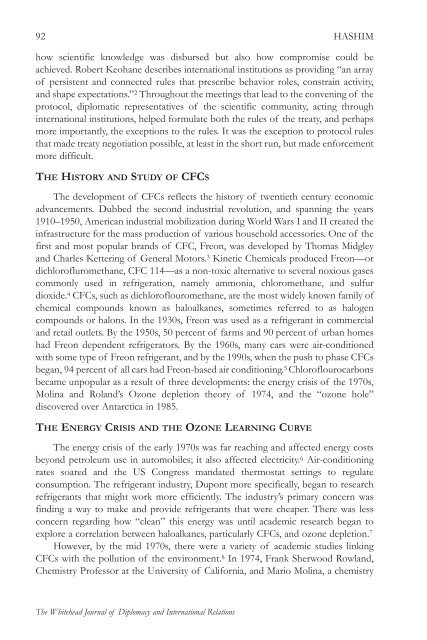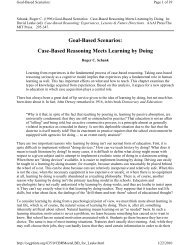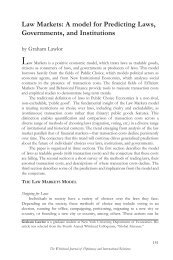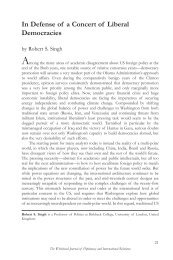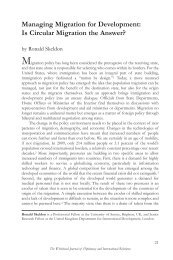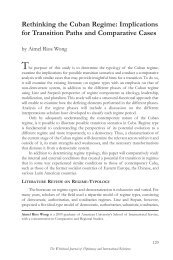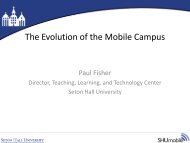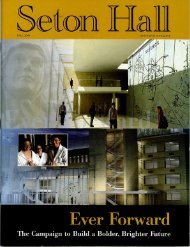Free Riders, Side Payments, and International Environmental ...
Free Riders, Side Payments, and International Environmental ...
Free Riders, Side Payments, and International Environmental ...
You also want an ePaper? Increase the reach of your titles
YUMPU automatically turns print PDFs into web optimized ePapers that Google loves.
92<br />
The Whitehead Journal of Diplomacy <strong>and</strong> <strong>International</strong> Relations<br />
HASHIM<br />
how scientific knowledge was disbursed but also how compromise could be<br />
achieved. Robert Keohane describes international institutions as providing “an array<br />
of persistent <strong>and</strong> connected rules that prescribe behavior roles, constrain activity,<br />
<strong>and</strong> shape expectations.” 2 Throughout the meetings that lead to the convening of the<br />
protocol, diplomatic representatives of the scientific community, acting through<br />
international institutions, helped formulate both the rules of the treaty, <strong>and</strong> perhaps<br />
more importantly, the exceptions to the rules. It was the exception to protocol rules<br />
that made treaty negotiation possible, at least in the short run, but made enforcement<br />
more difficult.<br />
THE HISTORY AND STUDY OF CFCS<br />
The development of CFCs reflects the history of twentieth century economic<br />
advancements. Dubbed the second industrial revolution, <strong>and</strong> spanning the years<br />
1910–1950, American industrial mobilization during World Wars I <strong>and</strong> II created the<br />
infrastructure for the mass production of various household accessories. One of the<br />
first <strong>and</strong> most popular br<strong>and</strong>s of CFC, Freon, was developed by Thomas Midgley<br />
<strong>and</strong> Charles Kettering of General Motors. 3 Kinetic Chemicals produced Freon—or<br />
dichlorofluromethane, CFC 114—as a non-toxic alternative to several noxious gases<br />
commonly used in refrigeration, namely ammonia, chloromethane, <strong>and</strong> sulfur<br />
dioxide. 4 CFCs, such as dichloroflouromethane, are the most widely known family of<br />
chemical compounds known as haloalkanes, sometimes referred to as halogen<br />
compounds or halons. In the 1930s, Freon was used as a refrigerant in commercial<br />
<strong>and</strong> retail outlets. By the 1950s, 50 percent of farms <strong>and</strong> 90 percent of urban homes<br />
had Freon dependent refrigerators. By the 1960s, many cars were air-conditioned<br />
with some type of Freon refrigerant, <strong>and</strong> by the 1990s, when the push to phase CFCs<br />
began, 94 percent of all cars had Freon-based air conditioning. 5 Chloroflourocarbons<br />
became unpopular as a result of three developments: the energy crisis of the 1970s,<br />
Molina <strong>and</strong> Rol<strong>and</strong>’s Ozone depletion theory of 1974, <strong>and</strong> the “ozone hole”<br />
discovered over Antarctica in 1985.<br />
THE ENERGY CRISIS AND THE OZONE LEARNING CURVE<br />
The energy crisis of the early 1970s was far reaching <strong>and</strong> affected energy costs<br />
beyond petroleum use in automobiles; it also affected electricity. 6 Air-conditioning<br />
rates soared <strong>and</strong> the US Congress m<strong>and</strong>ated thermostat settings to regulate<br />
consumption. The refrigerant industry, Dupont more specifically, began to research<br />
refrigerants that might work more efficiently. The industry’s primary concern was<br />
finding a way to make <strong>and</strong> provide refrigerants that were cheaper. There was less<br />
concern regarding how “clean” this energy was until academic research began to<br />
explore a correlation between haloalkanes, particularly CFCs, <strong>and</strong> ozone depletion. 7<br />
However, by the mid 1970s, there were a variety of academic studies linking<br />
CFCs with the pollution of the environment. 8 In 1974, Frank Sherwood Rowl<strong>and</strong>,<br />
Chemistry Professor at the University of California, <strong>and</strong> Mario Molina, a chemistry


